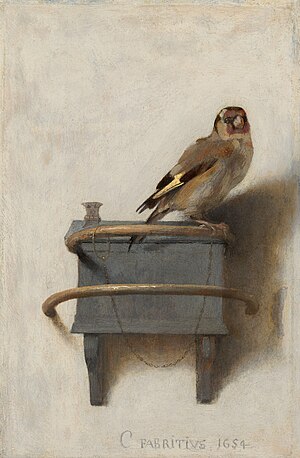The Goldfinch (painting)
| The Goldfinch | |
|---|---|
| Dutch: Het puttertje | |
 |
|
| Artist | Carel Fabritius |
| Year | 1654 |
| Type | Animal painting |
| Medium | Oil on panel |
| Subject | European goldfinch |
| Dimensions | 33.5 cm × 22.8 cm (13.2 in × 9.0 in) |
| Location | Mauritshuis, The Hague, Netherlands |
| Accession | 1896 |
The Goldfinch (Dutch: Het puttertje) is a 1654 animal painting by Carel Fabritius of a chained goldfinch. It is an oil painting on panel of 33.5 by 22.8 cm (13.2 by 9.0 in). The work belongs to the collection of the Mauritshuis in The Hague, Netherlands.
The painting is a trompe-l'œil of a European goldfinch (Carduelis carduelis) on top of its feeder that is attached to the wall. The feeder consists of two half rings and a blue container. The bird is sitting on the top ring, to which it is chained by its foot. The painting is signed "C fabritivs 1654" at the bottom.
In the 17th century, goldfinches were popular pets because they could be trained to draw water from a bowl with a miniature bucket. The Dutch title of the painting pertains to the bird's nickname puttertje, which refers to this custom and translates literally as 'little weller'.
The work was painted without major corrections, with only minor ones to the contours of the bird. Most of the painting is set up with large brush strokes, but details such as the chain are painted with more precision. Fabritius showed off his skill by painting the bird's head foreshortened.
It is one of three paintings that Fabritius painted in the year that he died. It is painted in a style distinct from Fabritius' master Rembrandt. In style, the work is closer to Fabritius' supposed pupil Johannes Vermeer, who further improved the skill of painting shadows. Art historians have found no hard evidence to support this master-pupil relationship.
As a trompe-l'œil, it is a unique work in Dutch Golden Age painting. It has been compared with Still-Life with Partridge and Gauntlets (1540) that Jacopo de' Barbari painted more than 100 years earlier.
...
Wikipedia
